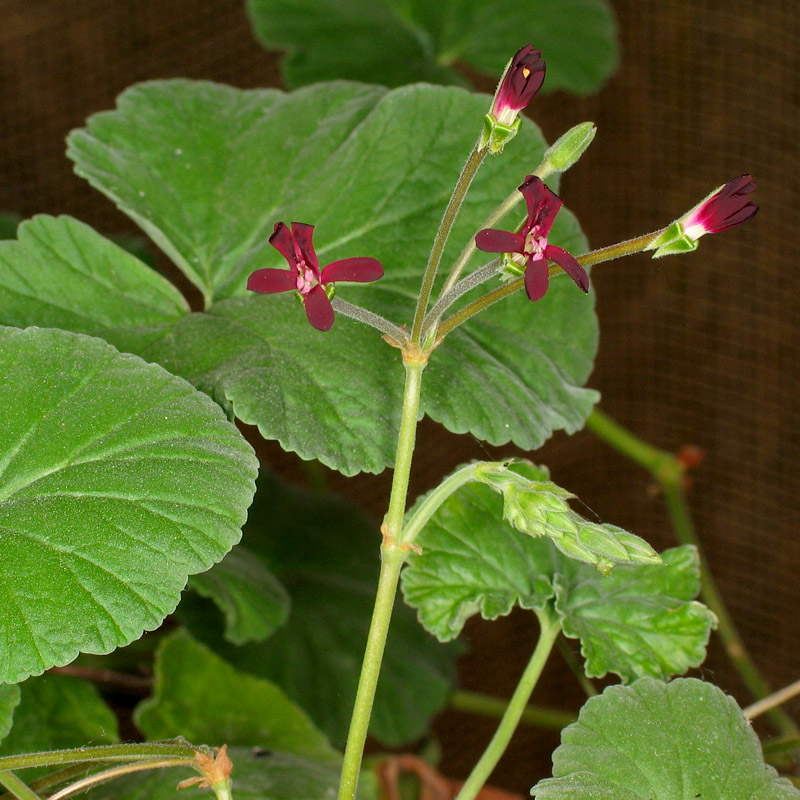Botanical name
Pelargonium sidoides DC.
Family
Geraniaceae
Common name
Cape geranium, African geranium, South African geranium
Information about the plant
Pelargoniums are native to South Africa and are commonly cultivated as ornamental plants but are often incorrectly referred to as “geraniums”. They are, in fact, very similar to the species of the genus Geranium - known as “cranesbill” - but the flowers are slightly monosymmetrical, while those of the Geranium species are radially symmetrical. As with the native meadow cranesbill (Geranium pratense), the fruits of the Pelargonium species also have a long beak. This beak acts as a catapult, launching the seeds far from the parent plant, which is a very distinctive mechanism of seed dispersal. The genus name Pelargonium, derived from the Greek 'pelargos' (= stork), also refers to the typical beak of the fruits. Thus, it can be translated as the “stork's beak” plant.
The African geranium is a small shrub, 20 to 80 cm high, found at altitudes of up to 2,000 m across Lesotho, through parts of Transvaal and the Free State province to the north-east of the Cape. Its cordate leaves are densely covered with glandular hairs, giving them a silvery, shiny appearance. The flowers are dark red to black. With its distinctive root system, the plant can survive drought and fires. The individual roots are 1 to 3.5 cm thick and are divided into short, tuberous and long, unthickened sections. It is also known as “African umckaloabo root”. “Umckaloabo” is made up of two words in the Zulu language: ‘umKhulkane’ meaning ‘ailment/disease of the lungs’, and ‘uUhlabo’ meaning ‘pain in the chest area’. This also documents the traditional use of the root.
In 1897, Charles Henry Stevens, an Englishman suffering from lung disease, traveled to South Africa upon his doctor’s advice. There, he was introduced to the African geranium by a Zulu who knew the plant and was successfully treated and cured with a root decoction. He then brought this secret medicine to England. The former missionary doctor Adrien Sechehaye learned of this remedy in 1920 and treated 800 patients with it in the following years. In 1930, he published his findings, which led to the introduction of umckaloabo root in Europe for the treatment of tuberculosis. Nowadays, however, tuberculosis can be treated more effectively with antibiotics, so umckaloabo root is no longer used for this purpose. Nevertheless, it is still valued in phytotherapy for respiratory complaints.
A second South African pelargonium species, Pelargonium reniforme Curtis, is also used medicinally, which is very similar in habit to the African pelargonium, but with magenta flowers and black marks on the petals.
Medicinally used parts of plants (herbal drug)
The dried root is used. For reasons of species protection, the drug comes primarily from crops in South Africa.
Constituents of the herbal drug
Pelargonium root contains coumarins, tannins, and simple phenolic compounds (e.g. gallic acid).
Quality of the drug
The quality of pelargonium root (Pelargonii radix) is specified in the European Pharmacopoeia (Ph. Eur.). According to the pharmacopoeia, pelargonium root may also be obtained from P. reniforme.
Medical applications
Recognised medical use
The HMPC has classified pelargonium root as a traditional herbal medicinal product (see “Traditional use”).
ESCOP: Symptoms of upper respiratory tract infections including common colds, such as stuffy or runny nose, sore throat, and cough.
Indications confirmed by clinical studies (approval): for the treatment of acute bronchitis.
Traditional use
Pelargonium root has been classified by the HMPC as a traditional herbal medicinal product (Article 16a of Directive 2001/83/EC). Based upon long-standing use, pelargonium root can be used to treat a common cold.
Herbal drug preparations in finished dosage forms
- Alcoholic extracts in drops
- Dried extracts in tablets
Dosage
Finished medicinal product: see patient information leaflet.
Tea: Pelargonium root is best used only in the form of extracts as a finished medicinal product.
Preparation of a tea
Not applicable.
Notes
There have been a few reports of hepatotoxic reactions associated with the administration of pelargonium root. If liver-toxic effects are noticed, the use of pelargonium root should be stopped immediately, and medical advice sought.
No safety studies are available for the use of pelargonium root during pregnancy and lactation. The use in children under 12 years of age is not recommended due to a lack of evidence.
Side effects
Allergic reactions are possible. Very rarely, slight gastrointestinal complaints or slight bleeding from the gums or nose.
Interactions
None known.
References
Herbal drug monographs
HMPC (2018, 2023), ESCOP (2016)
Further literature
Commentary on the European Pharmacopoeia (Pelargonium root, No. 2264)


